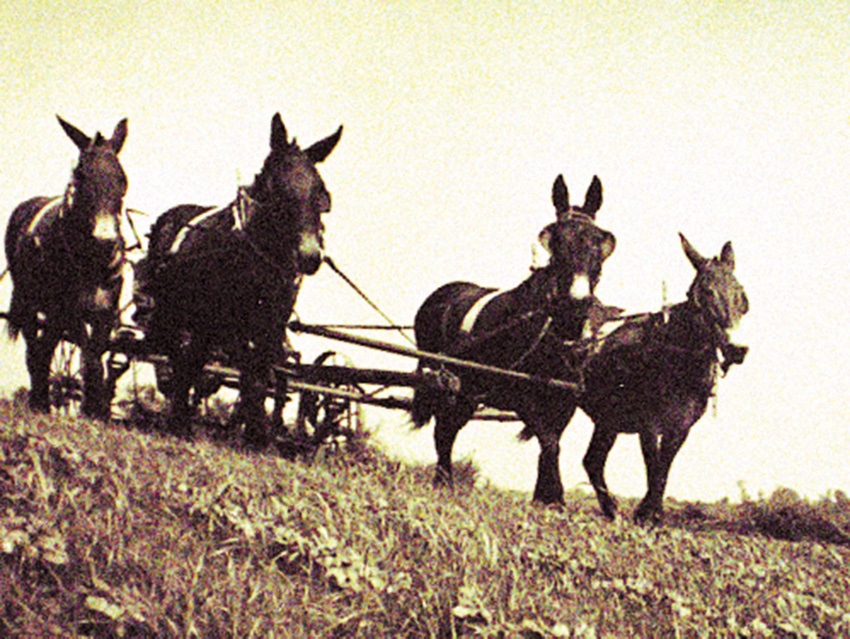
In 1943, 14-year-old Ray Young farmed by himself, and continued doing so in ’44 and ’45 while attending school in north central Louisiana. His father worked away from home as a bridge builder, and his two older brothers went away to WWII.
“I don’t think we had a board meeting and decided that’s what we’d do,” Young recalls. “It just kind of got decided that I’d run the farm, and that Dad would come home on weekends and line me up on what I should do the next week.”
A neighbor had a Ford 8N tractor, but Young used plow mules because, he says, “Dad saw no sense in buying tractors — which were just something to break down. Mules didn’t break down if you gave them enough to eat.”
Young farmed two miles away from a little town called Hico, which had four grocery stores, a grist mill, a school, a post office, and a barbershop. His family farm had 200 acres, but much of that was in trees and in pasture.
“Before WWII came along, we had two families living on our farm,” he says. “We furnished the house and food, and farmed 30 acres. But when I farmed by myself, eight or nine acres was about all I could do while farming full time and going to school full time. When I got out of school, it was to go straight to the field.
“I had five acres of cotton, four acres of corn, a pea patch, a potato patch, and a cane patch. We also raised three hogs every year, and had a hog-killing in the fall. The fatter the hog, the better, because that’s where we got our cooking shortening for a year.”
DIDN’T BUY MUCH
Young’s family grew most everything they ate. They never bought meal; instead, they hauled their corn to the town’s grist mill that operated on shares — the mill got a share for grinding the corn.
“We bought a little flour for biscuits for breakfast, and just a little sugar. We had a cane patch, and we’d cut the cane and carry it to the mill for cane syrup. We’d make 1,000 to 1,100 gallons of cane syrup every year, and Dad sold syrup in the winter for 40 cents or 50 cents per gallon. It didn’t take many dollars back then, since we raised ‘most everything we ate.”
Cotton averaged about 9 cents a pound in most of those years, and Young usually made two bales on five acres — a quarter bale per acre. “That was a pretty good crop,” he says. “The boll weevil was eating us up, but we didn’t know what to do about it.”
He had to get up and feed the mules before daylight, and have the harnesses and everything else ready to go at daylight. He could plant two acres a day on a good day. “We put out fertilizer when we planted cotton, on top of a bed we had made in the spring with a turning plow. We ran a mule-drawn fertilizer distributor with a blue hopper over the top of the bed. The distributor held 50 pounds of fertilizer. The analysis was 4-8-4, which was strong stuff back then.
‘UNTIL IT WAS DARK’
“I would get on top of the beds on the fertilizer trip and open up the furrow on top of the bed — it wasn’t the easiest thing in the world to walk on top of the bed following a mule. I plowed down and back, opening up a furrow on top of the bed and putting out fertilizer.
“I’d go down and back two or three times, and then on the turnrow I would unhook from the fertilizer distributor and hook to the planter before the ground dried out too much. I’d plant those three rows, and then unhook the planter and re-hook the fertilizer rig and repeat. That’s what I did all day long, until dark. Then I began all over again the next day. Nobody ever told us how hard that was.
“I went to the field with my seed and fertilizer on a ground slide. One mule can’t pull a wagon, but he can pull a heavily-loaded ground slide. We saved our seed, so we didn’t have the cost of buying new seed, and we planted about 30 pounds of cotton seed per acre.
“That was the way of farming in the hills in north central Louisiana. There were very few tractors in our area at that time. It was another five or six more years before tractors really came into our part of the world.”
Cotton was all hand-picked. Pickers were paid 50 cents per 100 pounds, or one-half cent, and could pick from 200 pounds to 300 pounds a day. “A good picker could pick 350 pounds a day, but it was highly unusual. It took six or seven people to pick a bale of cotton in a day. Today’s baler pickers will pick 90 acres to 100 acres a day; it would take 2,000 hand pickers to pick as much as one of the new machines will pick.”
‘OUT OF DAD’S POCKET’
The only time Young’s father borrowed money was when he bought the family farm in 1931, on a 40-year loan with the Federal Land Bank. He paid it off in 10 years.
“We farmed out of Dad’s pocket —we never had crop production loans,” he says. “Back then, it cost $6 or $7 per acre to farm cotton; you saved your own seed, put out $2 worth of fertilizer, and you seldom sprayed bugs. We didn’t know what to spray them with.
“But, if leaf worms got into the crop late in the year and started to strip the leaves off, we’d put arsenic on them. The basic product was Paris Green, a highly concentrated form of powdered arsenic that we mixed with flour. We would go out at night and shake it out of a flour sack as we walked through the field. The night dew helped stick the product on the plant. Also, the wind is a lot calmer at night, so the dust didn’t blow so bad — you could walk fast enough to get away from the dust. Some growers used mules with a duster on a stick laid across the saddle.”
In the early ’40s, Young says, every little town had a gin that could gin about 50 bales a day. On the Young farm, there was a cotton house in almost every field. “We would pick cotton, weigh it, and dump it in the cotton house, which would hold one or two bales.
“Then, on a rainy day, we’d take a wagon with side planks and go load about a bale from a cotton house, and go sit in line at the gin. We hauled our bales home from the gin and put them in our front yard. Dad would then sell cotton whenever a cotton buyer offered the price he wanted.”
About the Author(s)
You May Also Like




